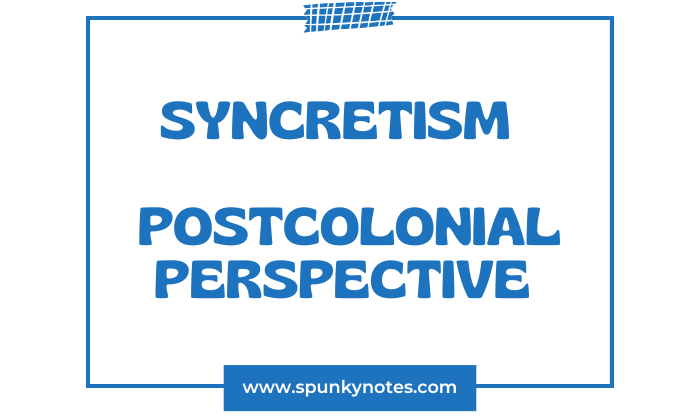
Q. Define Syncretism in Postcolonial Perspective.
Definition of Syncretism
Syncretism is the process of blending diverse cultural, religious, or philosophical traditions to form new systems, beliefs, or practices. It occurs when distinct cultures or ideologies come into contact and begin to influence one another.
This blending can result in the creation of entirely new traditions or the adaptation of existing ones. Syncretism often emerges as societies adapt to external pressures such as colonization, trade, migration, or the imposition of foreign ideas.
It reflects the ability of cultures to merge and evolve, creating unique identities in response to changing historical and social conditions.
Key Features of Syncretism
1- Cultural Interaction
Syncretism is rooted in the interaction between different cultures. When groups encounter each other through migration, trade, or conquest, their traditions influence one another, leading to blended practices.
2- Adaptation
It shows how societies respond to external pressures by adopting and modifying foreign elements to fit their existing cultural frameworks.
3- Creation of New Systems
Syncretism often results in entirely new traditions, beliefs, or practices that combine elements from multiple sources.
4- Resistance and Preservation
While syncretism involves adaptation, it also reflects resistance. Societies preserve their core identities by incorporating external influences into their traditions.
Examples of Syncretism
Religious Syncretism
Afro-American Religions: Religions like Santería and Voodoo blend African spiritual traditions with Catholicism. These syncretic religions emerged during colonization when enslaved Africans preserved their beliefs by merging them with the dominant Christian faith.
Day of the Dead (Día de los Muertos): This Latin American tradition combines Indigenous beliefs about honouring ancestors with Catholic practices introduced by Spanish colonizers.
Hindu and Islamic Influences in India: Sufi traditions in India integrate Islamic spirituality with Hindu practices, creating a unique form of religious expression.
Linguistic Syncretism
Creole Languages: Haitian Creole and Jamaican Patois are syncretic languages merging European vocabulary with African grammar and syntax.
These languages developed in colonial settings where enslaved and colonized peoples adopted the colonizers’ language but reshaped it to reflect their own cultural identities.
Artistic Syncretism
Music: Jazz is a syncretic art form that combines African rhythms with European harmonic structures. It emerged in the United States due to cultural exchanges in a racially diverse society.
Caribbean Art: Caribbean art reflects African, European, and Indigenous influences, blending styles and symbols from different traditions.
Philosophical Syncretism
The blending of ideas from Greek, Persian, and Indian philosophies during the Hellenistic period is another example of syncretism. These exchanges influenced major traditions like Neoplatonism and early Christian thought.
Syncretism in Historical Contexts
Colonial Era
Syncretism played a significant role during colonization. Colonizers often imposed their religions, languages, and cultural practices on Indigenous populations.
However, Indigenous peoples integrated these influences into their own traditions, creating syncretic systems. For example:
The Spanish conquest of the Americas led to the fusion of Catholic rituals with Indigenous spiritual practices.
African slaves in the Americas preserved their cultural heritage by blending it with the dominant European systems.
Trade and Migration
Trade routes like the Silk Road facilitated cultural exchanges between Europe, Asia, and Africa. These interactions produced syncretic traditions in art, language, and religion.
For instance, Buddhism in China adopted elements of Taoism and Confucianism to appeal to local populations.
Modern Syncretism
In contemporary society, globalization has increased the blending of cultures. Fusion cuisine, world music, and hybrid art forms are examples of modern syncretism, reflecting the interconnected nature of today’s world.
Syncretism in the Post-Colonial Perspective
In post-colonial contexts, syncretism reflects blending Indigenous traditions with colonial influences. Colonized societies used syncretism to adapt to foreign systems while maintaining their cultural identity. For instance:
Language: Colonized peoples reshaped the languages of the colonizers to reflect their own experiences and identities, as seen in Creole languages.
Religion: African slaves in the Americas merged their spiritual practices with Christianity to preserve their cultural heritage.
Art and Literature: Post-colonial artists and writers often combine local and colonial traditions to create new forms of expression, highlighting the complexities of cultural interaction.
Syncretism highlights the dynamic nature of culture. It shows how societies evolve by integrating new influences while preserving their unique identities.
In post-colonial contexts, syncretism represents both adaptation and resistance, reflecting the creativity and resilience of colonized peoples. Through syncretism, cultures find ways to survive, adapt, and thrive, even in the face of external pressures and challenges.
Difference Between Hybridity and Syncretism
Hybridity: Hybridity refers to merging cultural elements to create something new while preserving aspects of the original identities.
For example, Caribbean literature combines colonial literary forms with local dialects and themes, as seen in Derek Walcott’s Omeros.
Syncretism: Syncretism blends different traditions to form a completely new system. An example is Afro-Caribbean religions like Voodoo, which merge African spiritual practices with Christian rituals.
Focus
Hybridity focuses on combining cultures while retaining distinct elements. For instance, Chinua Achebe’s Things Fall Apart mixes African oral traditions with Western novel structures.
Syncretism focuses on blending traditions so thoroughly that a new system emerges. The Day of the Dead in Latin America combines Indigenous ancestor worship with Catholic rituals, creating a unique tradition.
Process
Hybridity occurs through the interaction of colonized and colonizers, producing mixed expressions. Caribbean authors like Derek Walcott merge colonial literary forms with local cultural themes and dialects.
Syncretism often arises from external pressures like colonization or conquest. For example, Indigenous peoples in the Americas aligned Catholic saints with their deities to adapt imposed Christian beliefs into their traditions.
Resistance
Hybridity: Post-colonial literature resists domination by merging native perspectives with colonial languages. Ngugi wa Thiong’o’s writings challenge colonial authority while using English to express African realities.
Syncretism: African slaves in the Americas resisted cultural erasure by blending Christianity with their own spiritual practices, forming systems like Santería.
Santería refers to a syncretic religion that emerged in the Americas, primarily in regions like Cuba, during the colonial era.
It blends the spiritual beliefs and practices of the Yoruba people from West Africa with elements of Catholicism, which was introduced by Spanish colonizers
Result
Hybridity creates a mixture where distinct elements are visible. For example, post-colonial architecture in India blends British colonial styles with local designs, retaining features of both.
Syncretism produces unified systems where original elements are harder to distinguish. The fusion of Indigenous and Spanish music in Mexico created mariachi, blending European instruments with native rhythms.
Hybridity and syncretism both describe cultural blending but differ in process and outcome. Hybridity retains visible elements of the original cultures, while syncretism forms entirely new systems through fusion.
Both concepts highlight post-colonial societies’ adaptive and creative responses to cultural contact and external pressures.

